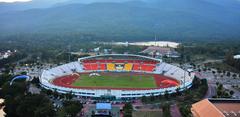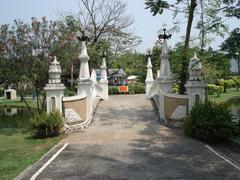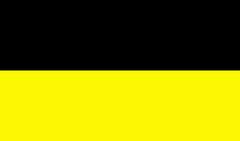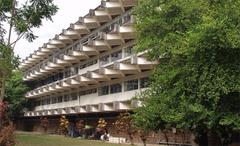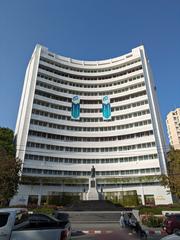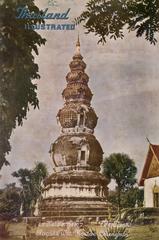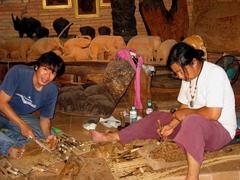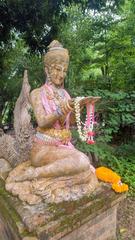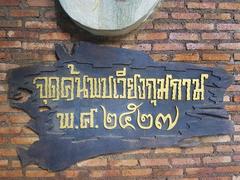Visiting Wat Saen Fang in Mueang Chiang Mai: Hours, Tickets, and Tips
Date: 31/07/2024
Introduction
Exploring Wat Saen Fang in Mueang Chiang Mai, Thailand, offers visitors a unique glimpse into the rich cultural and architectural heritage of Northern Thailand. Established during the late Lanna period (14th to 15th centuries), this temple has evolved through various renovations and restorations, notably under the patronage of Chao Kawilorot Suriyawong in the late 19th century. This period of restoration integrated Burmese architectural elements into the existing Lanna style, creating a distinctive blend that continues to draw both local and international tourists (Wikipedia).
The temple complex is renowned for its unique structures, such as the main chedi adorned with intricate carvings and gilded decorations, the viharn with its multi-tiered roof and elaborate wood carvings, and the ubosot used for important religious ceremonies. Beyond its architectural splendor, Wat Saen Fang is a vibrant center for Buddhist worship and community activities, hosting daily prayers, meditation sessions, and significant festivals like Visakha Bucha Day and Loy Krathong (Chiang Mai News).
Visitors to Wat Saen Fang can explore its rich history, admire its architectural marvels, and engage with its cultural practices. This guide offers comprehensive information on visiting hours, ticket prices, accessibility, and practical tips to enhance your experience. Additionally, it highlights nearby attractions to help you make the most of your visit to Chiang Mai. Whether you are a history enthusiast, an architecture aficionado, or simply seeking a serene spiritual experience, Wat Saen Fang is a must-visit destination in Northern Thailand.
Table of Contents
- [Historical Background](#historical-backgroundhistorical-background)
- [Architectural Features](#architectural-featuresarchitectural-features)
- [The Main Chedi](#the-main-chedithe-main-chedi)
- [The Viharn](#the-viharnthe-viharn)
- [The Ubosot](#the-ubosotthe-ubosot)
- [Cultural Significance](#cultural-significancecultural-significance)
- [Religious Practices](#religious-practicesreligious-practices)
- [Community Engagement](#community-engagementcommunity-engagement)
- [Architectural Features](#architectural-featuresarchitectural-features)
- [Practical Visitor Information](#practical-visitor-informationpractical-visitor-information)
- [Visiting Hours](#visiting-hoursvisiting-hours)
- [Ticket Prices](#ticket-pricesticket-prices)
- [Accessibility](#accessibilityaccessibility)
- [Visitor Tips](#visitor-tipsvisitor-tips)
- [Nearby Attractions](#nearby-attractionsnearby-attractions)
- [Preservation Efforts](#preservation-effortspreservation-efforts)
- [FAQ](#faqfaq)
- [Conclusion](#conclusionconclusion)
Historical Background
Wat Saen Fang, located in Mueang Chiang Mai, Thailand, is a temple with a rich historical tapestry that dates back several centuries. The temple’s origins are somewhat shrouded in mystery, but it is believed to have been established during the late Lanna period, around the 14th to 15th centuries. This period was marked by the flourishing of the Lanna Kingdom, which was known for its unique architectural and cultural contributions to Northern Thailand.
The temple has undergone numerous renovations and restorations over the years, reflecting the changing architectural styles and religious influences. One of the most significant renovations occurred in the late 19th century under the patronage of Chao Kawilorot Suriyawong, the ruler of Chiang Mai. This renovation introduced elements of Burmese architectural style, which can still be seen in the temple’s design today.
Architectural Features
Wat Saen Fang is renowned for its distinctive architectural features that blend Lanna and Burmese styles. The temple complex includes several structures, each with its own unique characteristics:
The Main Chedi
The main chedi (stupa) of Wat Saen Fang is a striking example of Burmese influence. It is adorned with intricate carvings and gilded decorations, making it a focal point of the temple complex. The chedi is believed to house relics of the Buddha, adding to its spiritual significance.
The Viharn
The viharn (assembly hall) at Wat Saen Fang is another architectural marvel. It features a multi-tiered roof with elaborate wood carvings and decorative elements. The interior of the viharn is equally impressive, with murals depicting scenes from the life of the Buddha and other religious motifs.
The Ubosot
The ubosot (ordination hall) is a smaller but equally important structure within the temple complex. It is used for important religious ceremonies, including the ordination of monks. The ubosot at Wat Saen Fang is characterized by its elegant design and serene atmosphere.
Cultural Significance
Wat Saen Fang holds a special place in the cultural and religious landscape of Chiang Mai. It is not only a place of worship but also a center for community activities and cultural preservation.
Religious Practices
The temple is an active site for Buddhist worship and rituals. Monks at Wat Saen Fang conduct daily prayers, meditation sessions, and other religious ceremonies. The temple also hosts important Buddhist festivals, such as Visakha Bucha Day and Loy Krathong, attracting both locals and tourists.
Community Engagement
Wat Saen Fang plays a vital role in the local community. It serves as a venue for various community events, including cultural performances, educational programs, and social gatherings. The temple’s involvement in community activities helps preserve and promote the cultural heritage of Chiang Mai.
Practical Visitor Information
Visiting Hours
Wat Saen Fang is generally open to visitors from 6:00 AM to 6:00 PM daily. It is advisable to check for any specific visiting hours or restrictions during Buddhist festivals or special events.
Ticket Prices
There is no admission fee to enter Wat Saen Fang. However, donations are appreciated to support the temple’s maintenance and community services.
Accessibility
The temple is accessible to visitors of all abilities. However, some areas may have uneven terrain or steps, so it is advisable to wear appropriate footwear.
Visitor Tips
Dress Code
As with all temples in Thailand, visitors to Wat Saen Fang are expected to dress modestly. This means covering shoulders and knees. It is advisable to wear loose-fitting, comfortable clothing that is appropriate for a religious site.
Photography
Photography is generally allowed within the temple complex, but it is important to be respectful. Avoid using flash photography inside the viharn and ubosot, as it can be disruptive to worshippers. Always ask for permission before taking photos of monks or other individuals.
Best Time to Visit
The best time to visit Wat Saen Fang is during the early morning or late afternoon when the temple is less crowded, and the weather is cooler. This allows for a more peaceful and contemplative experience. Additionally, visiting during one of the major Buddhist festivals can provide a unique cultural insight.
Guided Tours
For those interested in learning more about the history and significance of Wat Saen Fang, guided tours are available. These tours are often led by knowledgeable local guides who can provide in-depth information about the temple’s architecture, history, and cultural importance.
Nearby Attractions
While visiting Wat Saen Fang, consider exploring other nearby historical sites and attractions in Chiang Mai:
- Wat Chedi Luang: Another significant temple with a massive chedi and historical importance.
- Tha Phae Gate: A historical landmark and part of the old city walls.
- Chiang Mai Night Bazaar: A bustling market offering local crafts, food, and entertainment.
Preservation Efforts
Wat Saen Fang has been the focus of various preservation efforts to maintain its historical and cultural integrity. The Fine Arts Department of Thailand has been involved in several restoration projects to preserve the temple’s architectural features and artwork. These efforts ensure that future generations can continue to appreciate the temple’s beauty and significance.
FAQ
What are the visiting hours for Wat Saen Fang?
Wat Saen Fang is open daily from 6:00 AM to 6:00 PM.
How much are the tickets for Wat Saen Fang?
There is no admission fee, but donations are appreciated.
Can I take photos at Wat Saen Fang?
Yes, photography is allowed, but avoid using flash and always ask for permission before photographing individuals.
Conclusion
Wat Saen Fang is a testament to the rich cultural and religious heritage of Chiang Mai. Its unique blend of Lanna and Burmese architectural styles, coupled with its historical and cultural significance, makes it a must-visit destination for anyone exploring Northern Thailand. By following the visitor tips and respecting the temple’s traditions, visitors can have a meaningful and enriching experience at this remarkable site.
For more information on Wat Saen Fang and other temples in Chiang Mai, you can visit Chiang Mai A La Carte and Sunshine Seeker.
Visit and stay up to date with the latest information by following us on social media or downloading our mobile app.
References
- Wikipedia. (n.d.). Wat Saen Fang. Wikipedia
- Chiang Mai News. (n.d.). Wat Saen Fang: A Blend of Cultures. Chiang Mai News
- Chiang Mai A La Carte. (n.d.). The Ancient City of Chiang Saen. Chiang Mai A La Carte
- Sunshine Seeker. (n.d.). Chiang Mai Temples. Sunshine Seeker
